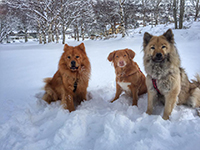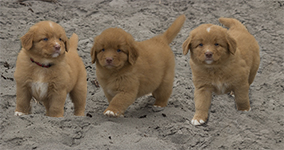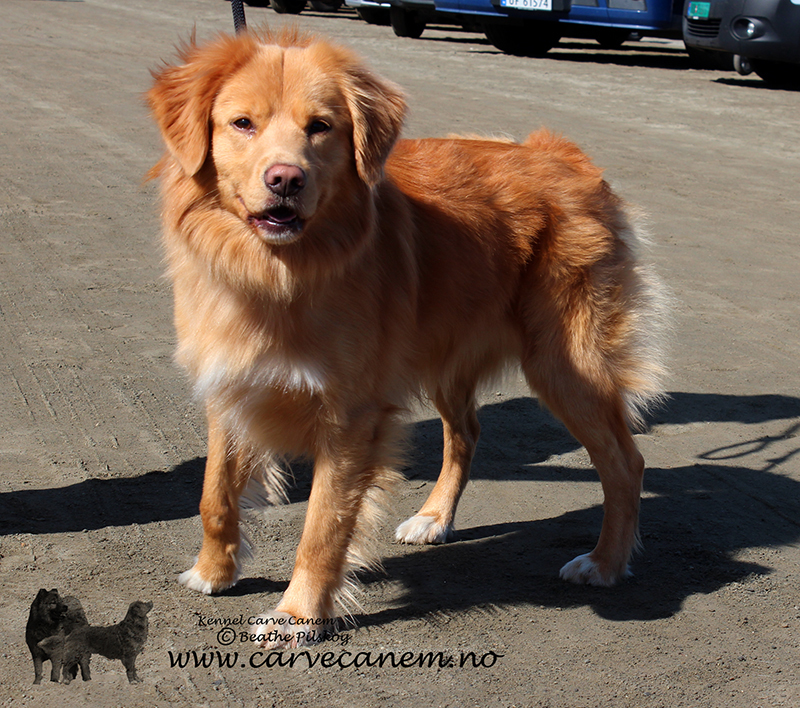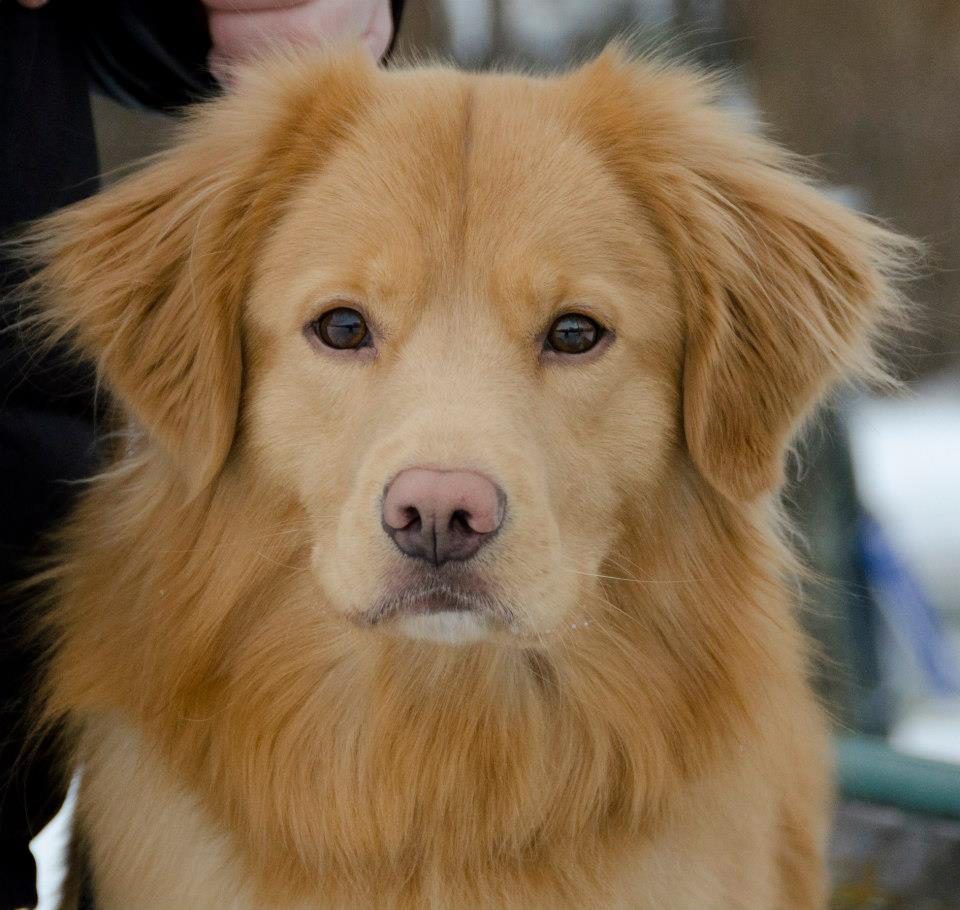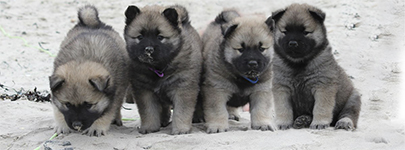O-kull - forventes høsten 2016
Lornford Rum Doodle og Carve Canem Ivy
Innavlsprosent i dogweb på åtte ledd er 0,439
Bono er født i det skotske høyland, midt i Whiskey-ruten. Han er 1 av 11 søsken, de 10 andre bor i Storbritannia. Ivy er en av 7 søsken.
Både Ivy og Bono har over 100 i HD-index hos NKK.
| HD-Index |
| Hundens HD-Index vises som et tall hvor 100 er rasens gjennomsnitt og et tall over 100 indikerer at dette individets HD-Index er bedre enn gjennomsnitt for rasen. |
Bonos eier kan fortelle at Bono er en trivelig og omgjengelig hund, som er familiens midtpunkt. Han elsker barn! Bono er en av ganske få tollere som har kjørt Metro i Paris, midt i turistsesongen - ingen problemer med det, så han er rimelig miljøsterk. Dem går spor med han og trener jakt, og syns dette er veldig moro.
Ivy kommer fra et kull på 7. 6 er helsesjekket med HD A og AA 0. Bono kommer også fra linjer med gode helseresultater
Søskene til Ivy har vist seg å være vakre og smarte. Dem har gjort det veldig bra både i utstillingsringen, sporkurs, lydighet, rally lydighet , redningshund og diverse andre morsomheter. En alsidig gjeng.
Ivy har vært på utstilling og fått cert, hun har også trent bruks sammen med NRH og syns dette er veldig kjekt.
Hun er en aktiv hund med mye motor.
Ivy er øyelyst 04.04.16 fri for øyesykdommer, med anmerkning på pigmentflekker. Dette er ufarlig.
Bono er øyelyst 09.07.14 og 16.10.15, begge gangene fri og uten anmerkninger.
Begge har tatt gentester for å sjekke om dem er bærere av sykdommer som valpene kan utvikle.
Ivy er PRA A (clear) etter foreldre, Bono er B (carrier). Det vil si at valpene kan bli bærer av øyesykdommen PRA, men ikke utvikle sykdommen.
Ivy er DE clear og DM carrier.
Bono er DM clear etter foreldre, så valpene vil ikke utvikle denne sykdommen. Gentest viser at han er DE clear, JADD clear, BUFF clear, CP clear og CLP clear.
Ivy
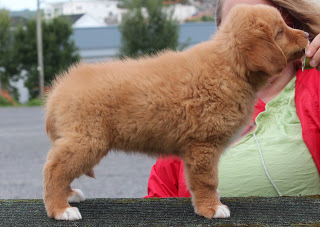
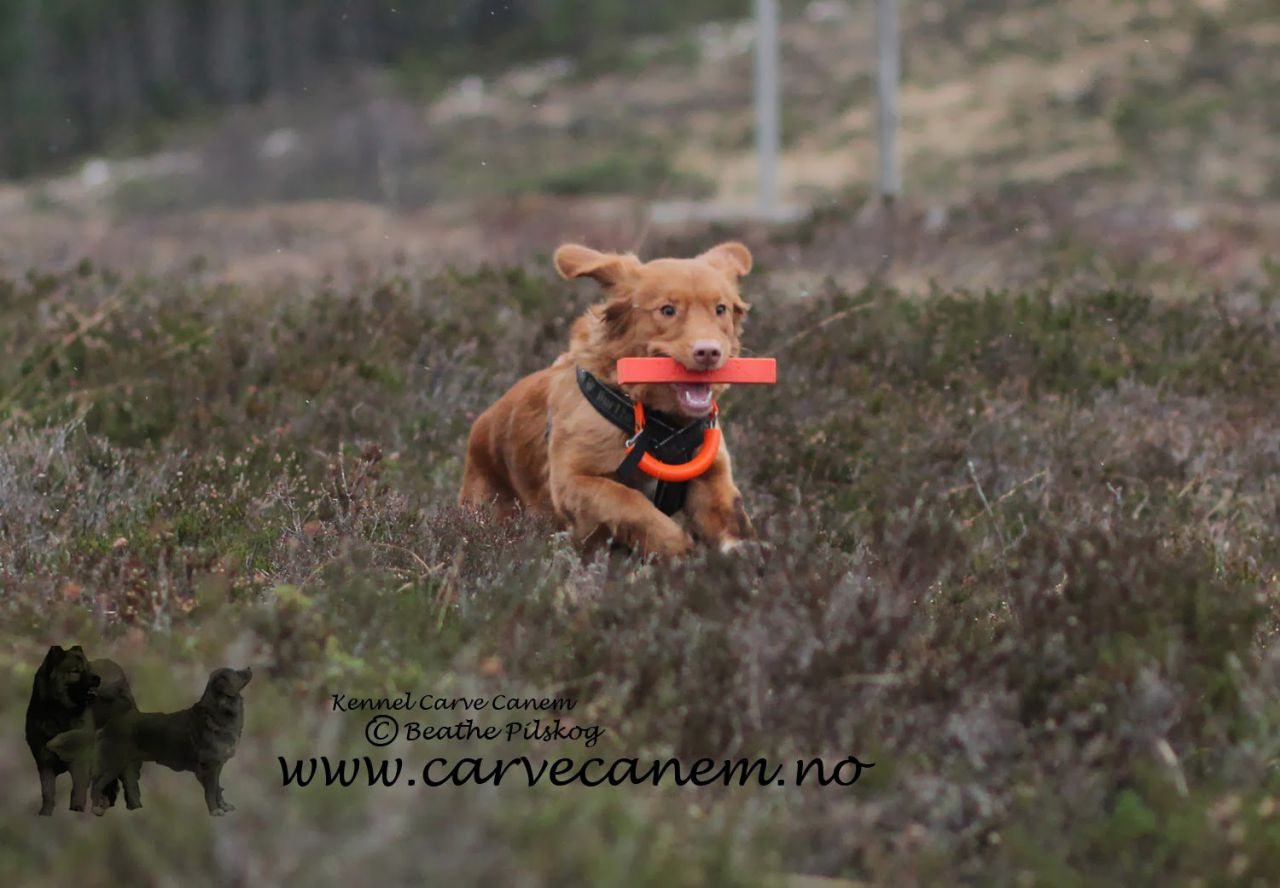
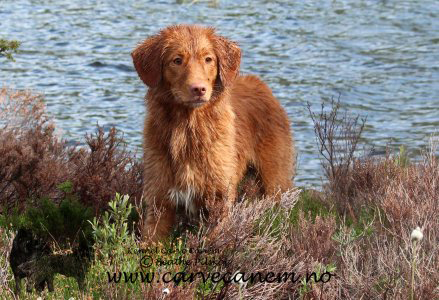
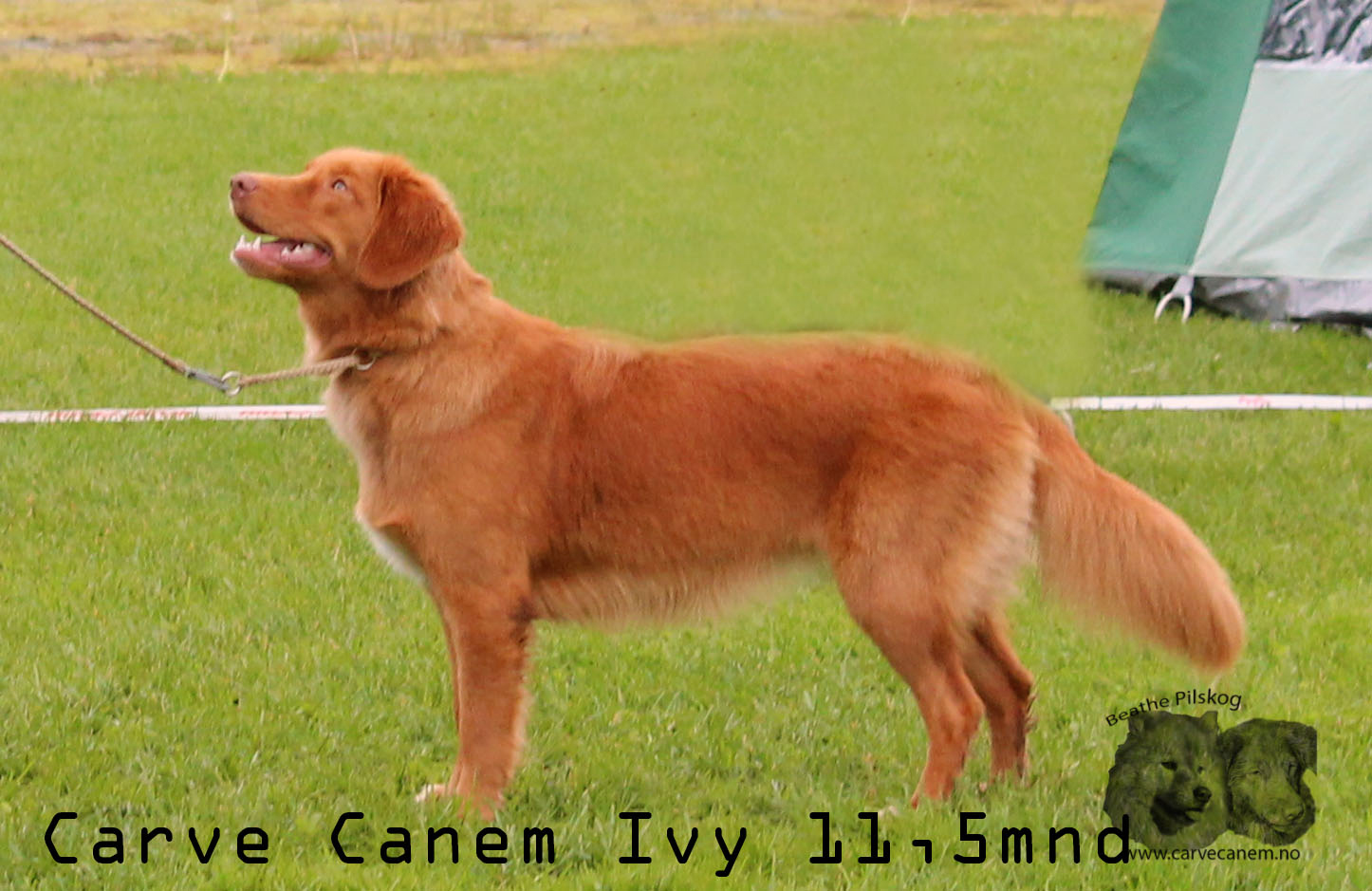

Bono
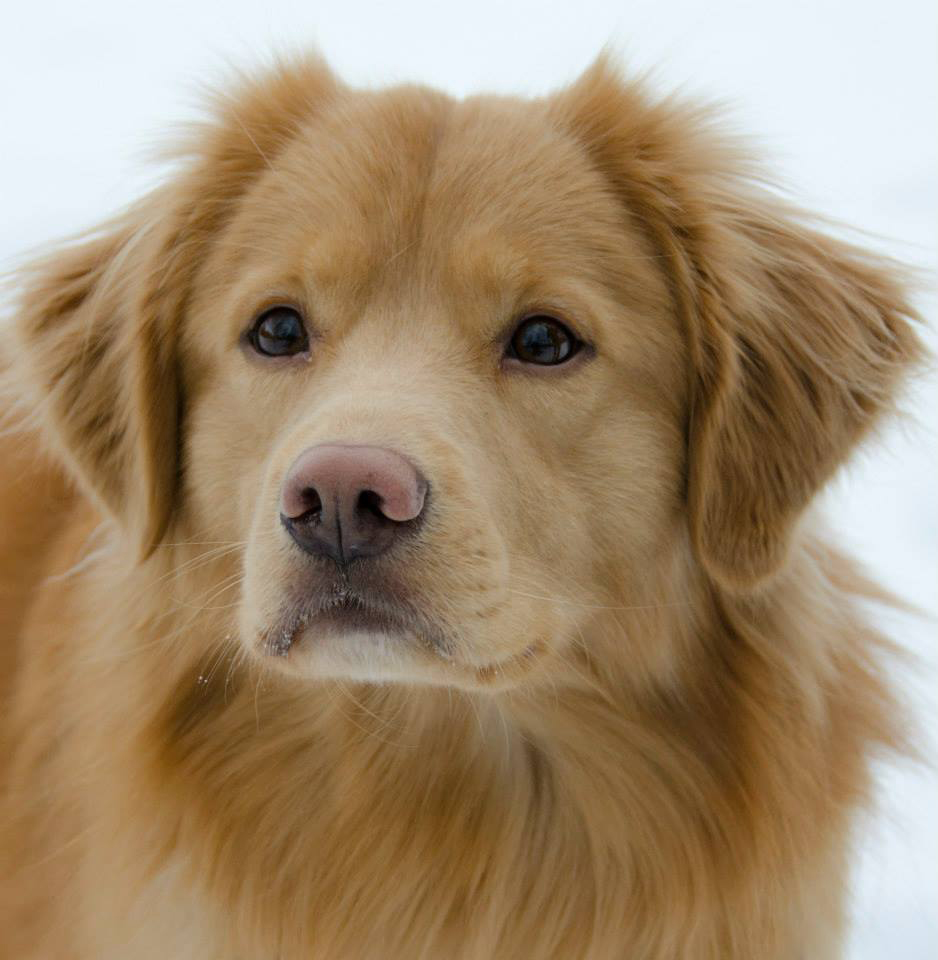
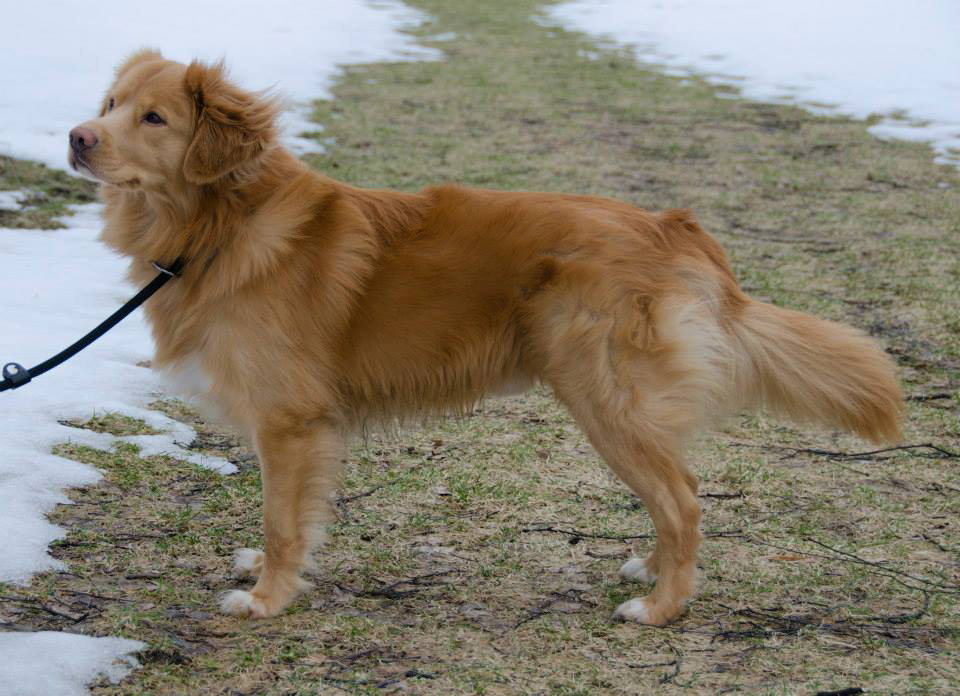
Info om gentestene hentet fra www.offa.org
BUFF (DILUTE COAT COLOR) IN THE NOVA SCOTIA DUCK TOLLING RETRIEVER (NSDTR)
Buff is a recessively inherited coat color variant that occurs in the NSDTR. Buff is a disqualifying feature for the show ring but otherwise appears to cause no health issues in the breed. Puppies are born a lighter shade of red that can appear silver in color. As they age they can sometimes darken to a more red color but they are lighter than they would be without the effect of the buff mutation.
Buff coat color is caused by mutations in the gene called melanophilin which also causes dilute coat color in many other breeds (Drögemüller C, U. Philipp, B. Haase, A-R Günzel-Apel T Leeb. A noncoding melanophilin gene (MLPH) SNP at the splice donor of exon 1 represents a candidate causal mutation for coat color dilution in dogs.Journal of Heredity (2007) 98(5):468-473). The mutation that causes buff is the same exact change in the DNA sequence that causes dilute.
CLEFT PALATE (CP1) IN THE NOVA SCOTIA DUCK TOLLING RETRIEVER (NSDTR)
A cleft palate is a birth defect whereby a hole (cleft) in the roof of the mouth (palate) develops in a puppy during gestation. Puppies born with cleft palate can experience difficulty nursing which will greatly increase their risk of developing aspiration pneumonia - a serious life threatening condition. There are multiple genetic causes of cleft palate within the NSDTR breed; however, the most common form has been identified as CP1.
CLEFT LIP/PALATE AND SYNDACTYLY (CLPS) IN THE NOVA SCOTIA DUCK TOLLING RETRIEVER (NSDTR)
Cleft palate is a hole (cleft) in the roof of the mouth (palate) that occurs during development of the puppy. Puppies are born with cleft palate. Cleft Lip is split in the lip and can occur on one or both sides of the mouth. Syndactyly is fusion of the middle two digits of the feet. The NSDTR breed has multiple genetic causes of cleft palate. A mutation test is already available for CP1 in the NSDTR which causes cleft palate. We have recently identified the mutation that causes a second form of cleft lip and cleft palate called CLPS. This mutation test is BREED specific and does not apply to any breed except the NSDTR.
JUVENILE ADDISON'S DISEASE (JADD) IN THE NOVA SCOTIA DUCK TOLLING RETRIEVER (NSDTR)
Addison’s disease (hypoadrenocorticism) occurs when the adrenal glands stop secreting the natural steroid hormones (glucocorticoid) and hormones (mineralicorticoids) necessary for the regulation of sodium and potassium levels in the blood. Addison’s disease can occur in any breed of dog and it has an average age of onset of 4 years. Addison’s disease is diagnosed by a veterinarian using a blood test called an ACTH stimulation test. The clinical signs of Addison’s disease can include lethargy, inappetance, vomiting and diarrhea.
In the NSDTR, a genetic form of this disease, called JADD, occurs in much younger animals. The average age of puppies affected with JADD is 5 months; however, puppies as young as 8 weeks and as old as 12 months of age have been identified.
Treatment of puppies affected with JADD requires both mineralicorticoid and glucocorticoid replacement therapy. Puppies can have other concurrent diseases including eye problems (corneal edema, conjunctivitis or uveitis) that may require specialized treatment.
DEGENERATIVE ENCEPHALOPATHY (DE)
Description:
Veterinary neurologists in Europe and America have recently recognized a new neurodegenerative disease in the Nova Scotia Duck Tolling Retriever (NSDTR). The disease is called Degenerative Encephalopathy with Sleep Disorders and Caudate Necrosis or simply Degenerative Encephalopathy (DE) for short. The term encephalopathy comes from the Greek words encephalo- (the brain) and pathy (disease) and simply refers to a disorder of the brain. In this encephalopathy there is degeneration of a region the brain called the caudate nucleus. The caudate nucleus is a part of the brain that is important in controlling movement and some aspects of behavior. In DE, this portion of the brain undergoes necrosis or complete destruction of the area. One of the manifestations of caudate necrosis is a very unusual change where the dogs vigorously act out their dreams, and are difficult to awaken. Hence the name Degenerative Encephalopathy with Sleep Disorders and Caudate Necrosis. Though this is a devastating disease, it does not appear to be common in the breed. Researchers at the University of Missouri have found a genetic mutation that is highly associated with DE. A DNA test for this mutation will permit the detection of dogs that have inherited two copies of the mutation and are at risk for developing the disease, and dogs that have inherited one copy of the mutation and have the potential of producing puppies that will develop the disease.
The OptiGen prcd-PRA Test
The OptiGen prcd-PRA test is a DNA-based test that helps you avoid one form of Progressive Retinal Atrophy (PRA). PRA refers to a group of diseases that cause the retina of the eye to degenerate slowly over time. The result is declining vision and eventual blindness. “prcd” stands for “progressive rod-cone degeneration” which is the type of PRA known in several breeds.


